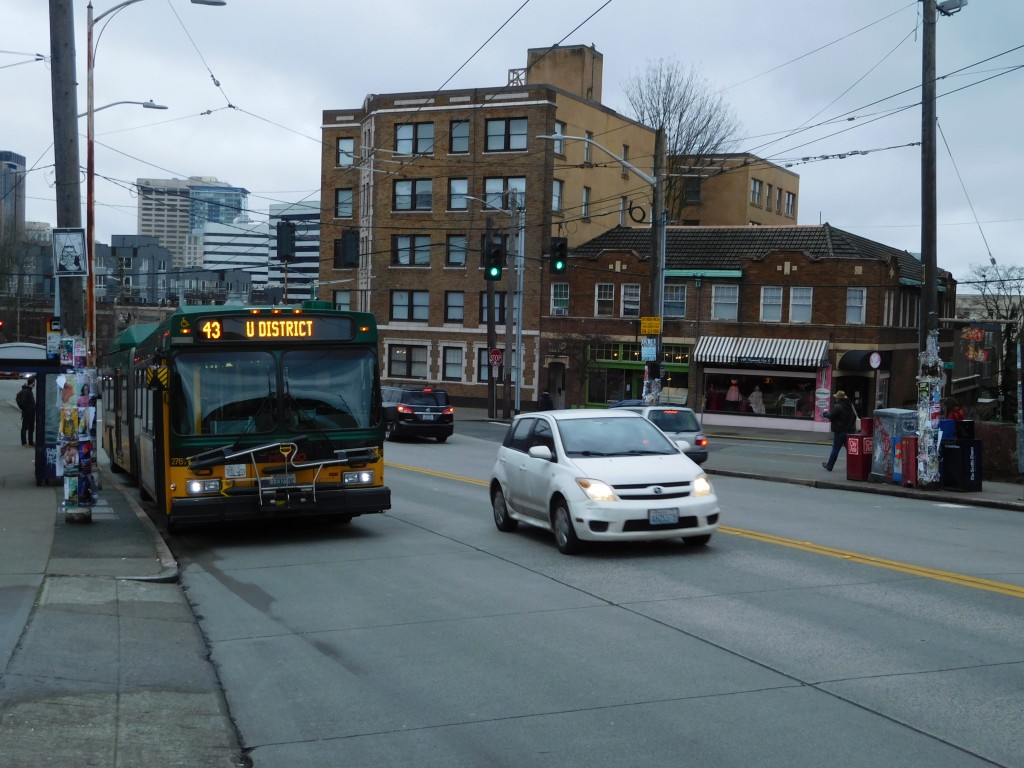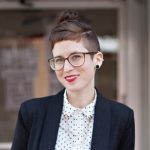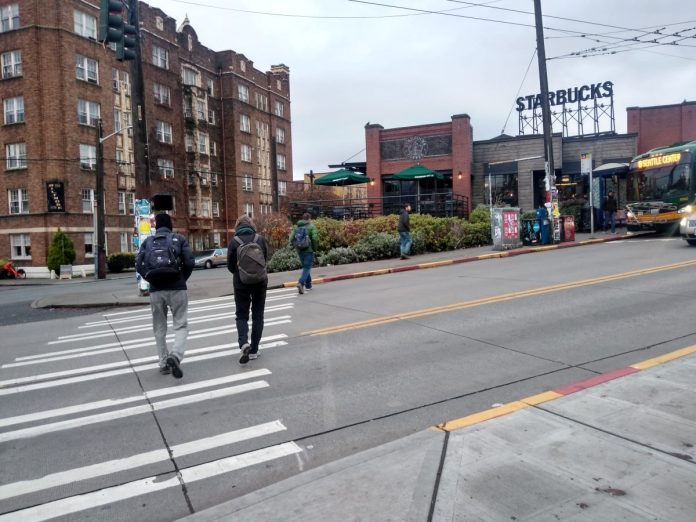I live a few steps from the awkward intersection of Summit and Olive, where bus-related improvements shortened the crossing distance for pedestrians within the last year or two. If you follow these types of projects, and don’t live nearby, you might think: “this is the heart of Capitol Hill, a transit-dense area where the bus can now stop in-lane—what a dream. A+ and well done SDOT.” But you’d be wrong.
Neighbors of mine will be familiar: you amble out of your residence, see the Carmelo’s Tacos sign beckoning, and find yourself asked to halt for an interminable length of time, a time you cannot possibly fill with anything but irritation–and then you’re liable to be staring a bus in the noisy, stinky rear when you finally do get the light. Increasingly, I’ve noticed pedestrians taking matters into their own hands and risking the sometimes speeding cars to get across the damn street before their coffee gets cold or they miss their train. I’ve started doing so myself, against my prior moral code. And once I started doing it as a pedestrian, I found myself tempted to do so while driving as well.
Trying to pull a motor vehicle onto Olive from adjacent residential streets invariably blocks crosswalks if there isn’t a perfect opening at just the right time—so I experimented recently with a move to merge into a line of traffic rather than wait for a proper opening. This less-than-legal move feels like a white lie—not sanctioned, but harms no one—when traffic’s moving at a pace I’ll describe as second-gear-and-below.
Coming off the I-5 exit ramp at 40 mph, Olive doesn’t exactly signal to drivers that they’re in a dense urban residential neighborhood. Luckily, mid-block crossings, strangely configured intersections, and non-sequenced lights somewhat hamper the free flow and often result in second-gear-and-below speeds. That’s a good thing, since going any faster would be terrifying when, for example, one is trying to make a left at Olive and Bellevue and fourteen other actors are trying to do other movements as well. I regularly witness elaborate dances taking place at such intersections where angled streets meet the grid, and trust they happen mostly in slow motion.
So improvements like the in-lane bus stop at Olive and Summit probably do help add to the general chaos of the urban street in a way that narrows the profile, slowing down cars. Combined with signal timing that goes against giving cars the sequential greens that enable third gear speeds, and this investment could have worked—by utilizing concrete and rules.
But what if there is no perfect engineering or design solution? What if concrete and rules are a more expensive and alienating way to manage the movement of people in a community? Bear with me for a second, but what if we stuck a giant temporary artpiece as a roundabout in the middle of Olive and Bellevue? What if we just… figured out how to get around each other?
Here’s where I’m going with this: we need fewer rules, and lower speeds.
At slow speeds, we can all look out for one another and get everyone where they’re going through the judicious application of eye contact, gestures, and care. I work for local government, so I feel confident when I say that the amount of tinkering we do with streets in dense areas is government overreach. We overdesign (*cough cough* Mercer Mess *cough*)—which also means we overspend, we overthink—to the detriment of community. Without traffic lights, without the state telling us when we can cross (the public right-of-way—it’s literally ours, we own it)—we could figure it out together.

It’s so obvious in the wee hours, when the streets are empty and you wonder why you are supposed to walk in these ridiculous right angles, totally unnaturally, and can’t just amble down your street at the angle that best skirts the buildings between you and your home (like my dog tries to do). I don’t need a curb keeping me to five feet of this cross section—I live here, and I’ll take the streets as I please. And during times of day when there are a lot of people out, I’d like to respectfully help each other get where we’re going, in whatever way those present deem best. Have you ever seen a pedestrian help stop traffic for a truck backing up into the street? Warms my heart every time.
I get that there’s a lot working against us here—we’re all living our isolated little lives in our little boxes, with our ears plugged up with sounds we choose on our phones—but I see potential for this ethos to permeate, because communities are built through relationships and interactions. What better way to foster interaction than make people figure out how to get around each other in the public right of way?
It only works when cars are going slow—first or second gear, absolutely deferring to people walking, rolling, and biking. It only works when we truly feel what a menace we are in our cars. It only works when we all do what we can to keep the bus moving. It only works when we communicate—make our needs known, ask others to see us. But if there is anywhere where that’s possible, it has absolutely got to be Capitol Hill. I think we can handle a little more chaos, if we care enough about each other—lights be damned.
Author’s note: I’m primarily a pedestrian and transit-rider; I also own a car and drive one to three times per month. I’m a former year-round dedicated cyclist who was doored in 2013 and basically hasn’t biked since. Also this article is not condoning unsafe behavior, nor does it purport to be a fully fleshed out policy proposal. Be responsible out there, and be good to each other.

Hayley Bonsteel
Hayley Bonsteel is a municipal long-range planner working in south King County. She has been an advocate for walkability, livability, and progressive planning in the Pacific Northwest for nearly seven years. Hayley is a daily Seattle pedestrian and transit rider, and serves on the Seattle Pedestrian Advisory Board. Thanks to a long Link+Sounder commute, she read 85 books last year.

